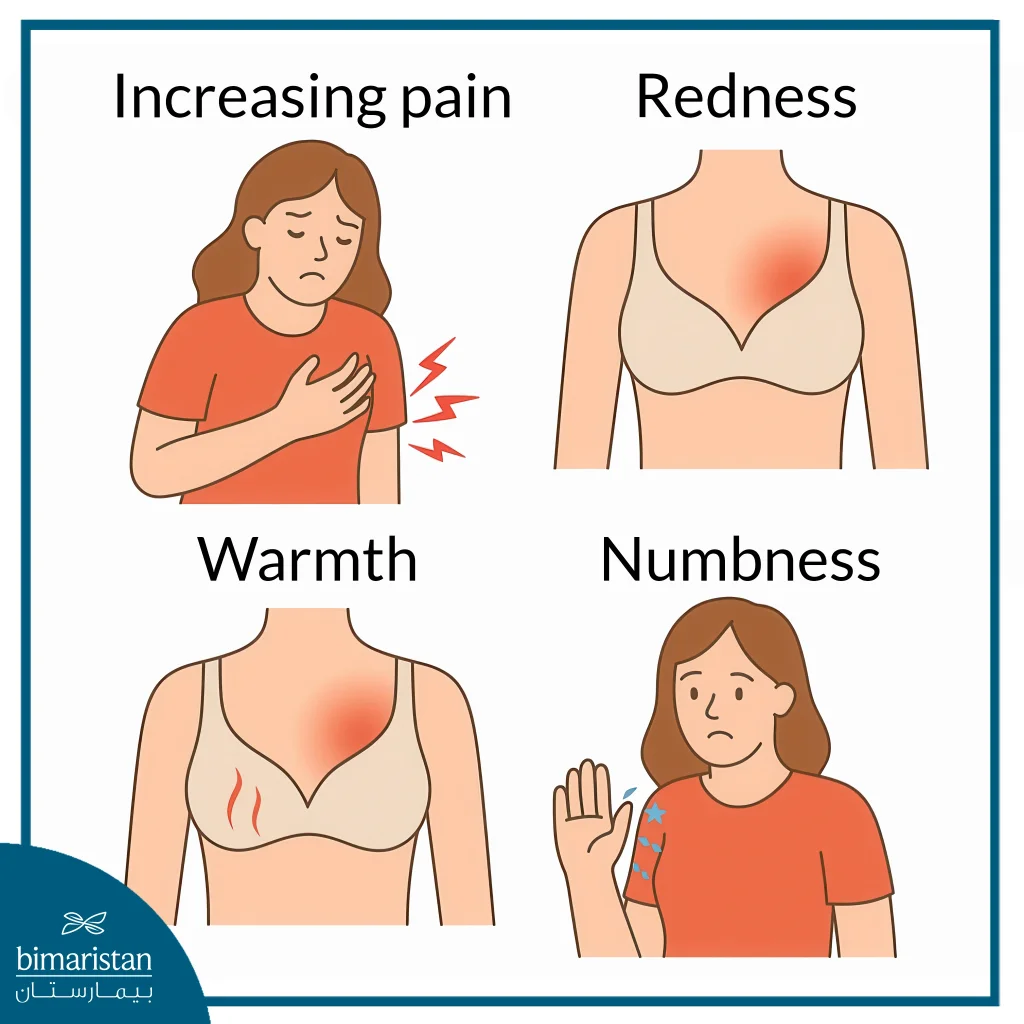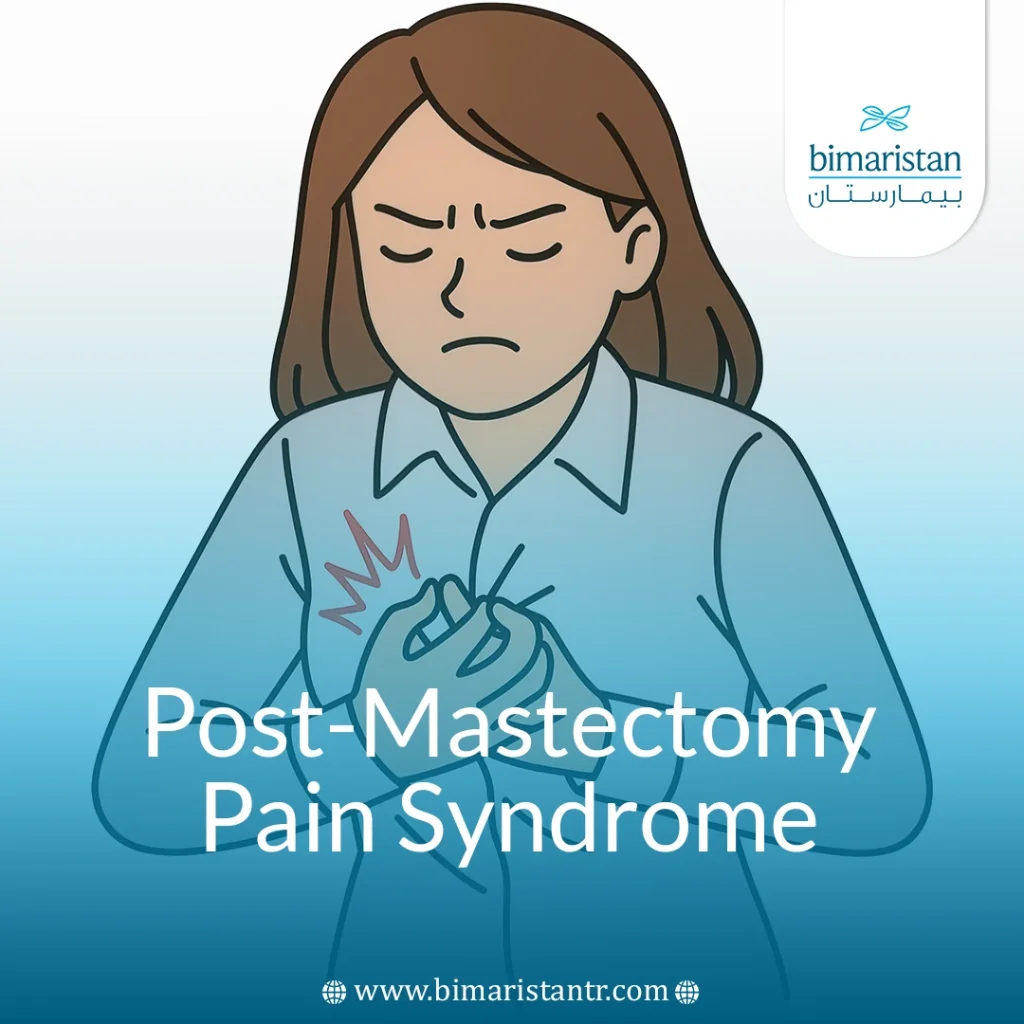Breast surgery is a common procedure, whether for therapeutic or cosmetic purposes, and the patient may feel post-mastectomy pain syndrome after surgery. In this article, we discuss the causes of pain after breast surgery, its types, duration, and how to alleviate it.
What is post-mastectomy pain syndrome?
Pain after breast surgery, sometimes known as post-mastectomy pain syndrome (PMPS), is a clinical diagnosis that refers to chronic pain that persists after mastectomy surgery at or near the surgical site, lasting more than three months after surgery, and is a distinct condition in its own right, not to be confused with Complex Regional Pain Syndrome or Phantom Breast Pain.
Symptoms can affect the front of the chest, the lateral side of the chest wall, the underarm, and the upper arm; however, chronic pain after breast surgery is not limited to mastectomy, but can be a complication of other types of breast surgery, including lumpectomy, post-mastectomy pain syndrome reconstruction, or cosmetic surgeries such as breast reduction or augmentation.
It is normal to experience pain after breast surgery, especially in surgeries in which tissue is removed from the upper outer part of the breast or from the armpit area. The cause of pain after breast surgery is believed to be nerve damage during surgery, and the pain can be sharp, dull, or burning.

Common causes of post-mastectomy pain syndrome
Post-mastectomy pain syndrome is usually the result of irritation to one or more nerves in the chest wall, which may be trapped in scar tissue or cut during surgery:
- Surgical incisions
- Fluid or blood pooling
- Swelling and muscle tightness in the chest, shoulder, or arm muscles
- A painful mass of nerves that grows at the end of the severed nerve
- Additional procedures such as surgical drains or implants
- Psychological factors can also play a role in the development of pain
Expected duration of post-mastectomy pain syndrome
The duration of post-mastectomy pain syndrome varies according to the type of surgery and the patient’s health status, as the pain after surgery is characterized by 3 to 7 days as acute and clear and is treated with analgesics such as paracetamol and anti-inflammatories, and in some cases with mild opiates, and the pain begins to gradually improve within 2 – 4 weeks. 4 weeks, but discomfort or a feeling of tightness remains, while pain persists in 20-30% of cases and turns into chronic pain that lasts for months and even years, especially after lymphadenectomy or radiation therapy, but it gradually subsides or disappears with appropriate treatment.
When should I see a doctor?
See a doctor when there are danger signs such as:
- Pain that gradually increases
- Severe redness or heat in the area
- Abnormal discharge
- Permanent numbness
- Localized hyperthermia
When is post-mastectomy pain syndrome a sign of complications?
Post-mastectomy pain syndrome is normal for the first few days or weeks, but it is a sign of complications if it:
- Burning or tingling pain weeks to months after the procedure
- Pain with difficulty moving the arm or shoulder
- Sudden pain with a lump under the skin
- Pain with signs of inflammation
How to deal with post-mastectomy pain syndrome?
Post-mastectomy pain syndrome can be treated with either pharmacologic therapy, and pharmacologic options include the following:
- Simple analgesics (paracetamol, anti-inflammatories)
- Neuropathic medications for neuropathic pain, such as anti-epileptic medications
Pain after breast surgery can also be treated with non-pharmacological treatments, including:
- Nerve block is a treatment that provides temporary and quick relief from pain by injecting a local anesthetic into the affected nerves
- Physical therapy through strengthening exercises and regular massage
- Acupuncture
- Yoga
- Cold compresses
- Rest and sleep position
- Psychological support and education
Is post-mastectomy pain syndrome different depending on the type of surgery?
The post-mastectomy pain syndrome varies clearly depending on the surgery, as the pain is mild to moderate in partial lumpectomy and concentrated in the tumor or wound site and goes away within 2-4 weeks in most cases, and rarely causes chronic neuralgia, while the pain is moderate to severe in complete lumpectomy, especially in the early days, the pain extends to the chest, and may extend to the armpit and arm, and may last for more than 3 months.
In the case of breast reconstruction and implants, the patient may feel compressive or pulling pain due to the stretching of the skin and tissues, depending on the location and size of the implant, and rarely causes chronic pain, as for lymphadenectomy, it is one of the most important reasons that lead to chronic pain after breast surgery, and causes burning or tingling pain in the armpit and arm.
Neuralgia after breast surgery
Neuropathic pain after breast surgery, known as post-mastectomy pain syndrome (PMPS), is a chronic pain syndrome caused by nerve damage after breast cancer surgery, lasting for more than three months. Nerve damage can occur during surgery due to nerve cutting or stretching, and the intercostal nerves in the upper outer part of the breast are most susceptible to injury.
To diagnose post-mastectomy pain syndrome (PMPS), the doctor will usually perform a clinical examination and review the patient’s medical history, and may ask the patient to describe the location and severity of the pain, as well as any other symptoms:
- Imaging tests such as X-rays, computerized tomography (CT) scans, or magnetic resonance imaging (MRI), are used to evaluate the breast and surrounding tissues for any abnormalities or injuries that may be causing the pain.
- Nerve conduction studies measure the speed and strength of nerve signals to help determine the presence of nerve damage.
- Psychological assessment: A mental health professional may be consulted to assess the patient’s psychological state and the extent to which psychological factors affect the pain.
Tips to minimize post-mastectomy pain syndrome and speed recovery
The following tips should be followed in order to minimize pain after breast surgery:
- Light early movement
- Breathing exercises and shoulder exercises
- Good nutrition
- Regular medical follow-up
In the end, post-mastectomy pain syndrome is a common feeling that can be managed by various means, and most cases improve over time, but communication with your doctor is essential to monitor your recovery and avoid complications.
Sources:
- Bamford, C., Thomas, J., Bond, M., Leonard, R., Ferguson, S., & Dyson, S. (2005). Pharmacological and other interventions for post-mastectomy pain syndrome in adults. Cochrane Database of Systematic Reviews, 4, CD003174.
- Scottish Cancer Network. (n.d.). Post-breast-surgery pain. In Scottish cancer network clinical management pathways: Breast supportive care. Retrieved July 10, 2025,

